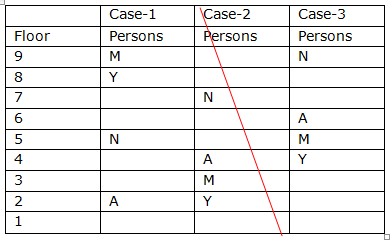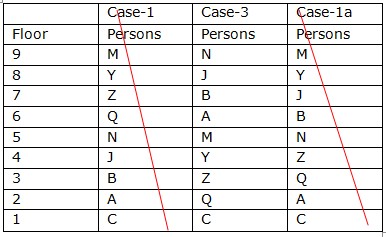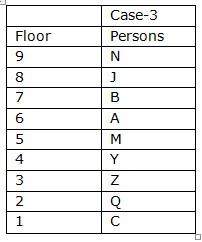Question
Who among the following lives just below of the floor
of Y? Study the following information carefully to answer the given question: Nine persons i.e. A, Z, B, Y, C, N, M, Q and J live on a separate floor of a nine floored building but not necessarily in the same order. The ground floor is numbered as 1, the first floor is numbered as 2 and so on until the topmost floor is numbered as 9. A does not live on the odd numbered floor and doesn’t live just below of the top floor. There are two persons live between A and N, who lives above of the floor in which A lives. Z lives just above of the floor of Q. B lives just below of the floor of J. There are three persons live between N and M, who lives just above the floor of Y. Both B and Q do not live on ground floor. Q lives below of the floor of Y but not just below. The number of persons between J and M is same as between C and Y.Solution
A does not live on the odd numbered floor and doesn’t live just below of the top floor. We get three possibilities here i.e. Case 1, Case 2 and Case 3. There are two floors gap between A and N, who lives above of the floor in which A lives. There are three persons live between N and M, who lives just above the floor of Y.  From the given statements, Q lives below of the floor of Y but not just below. Here Case 2 is ruled out. Both B and Q do not live on ground floor. Z lives just above of the floor of Q. B lives just below of the floor of J. Here, one more case is added i.e. Case 1a.
From the given statements, Q lives below of the floor of Y but not just below. Here Case 2 is ruled out. Both B and Q do not live on ground floor. Z lives just above of the floor of Q. B lives just below of the floor of J. Here, one more case is added i.e. Case 1a.  From the given statements, the number of floors gap between J and M is same as between C and Y. Now Case 1 and Case 1a are eliminated here. So, the final arrangement is such as-
From the given statements, the number of floors gap between J and M is same as between C and Y. Now Case 1 and Case 1a are eliminated here. So, the final arrangement is such as- 
Which of the following symbols should be placed in the blank spaces, respectively (in the same order from left to right ) in order to complete the given...
Statements: W ≤ T = R; T < U < S; X = W ≥ Y
Conclusions:
I. S > Y
II. W ≥ S
III. U ≥ Y
Statements:
J ≥ F = P; F > S ≥ A; S ≥ B < C
Conclusions:
I. C > A
II. B < J
Statements: J < K; L = M; K >N ≥ L
Conclusions:
I. J < L
II. N = M
Statements: Q $ Z % C # T @ H
Conclusions:
I. Z # H
II. Q © T
III. H % Z
Statements: B ≤ C < E; D ≤ F ≤ G; E = D; A > B
Conclusions:
(i) E ≥ G
(ii) A < E
(iii) B ≤ G
(iv) C < F
Statement: M < N ≤ O = P, Q ≥ O ≤ R ≤ Z
Conclusion: I. Q > M II. Z > M
...Answer the following question based on the direction given below.
If 'A#B' means 'A is equal to B'
'A@B' means 'A is greater than B'<...
In the question, assuming the given statements to be true, find which of the following conclusion(s) among the three conclusions is/are true and then g...
Statements: G ≤ D < F; C > D = E; A ≤ B < C; G > H
Conclusions:
I. C > H
II. F > A
III. E < B
Relevant for Exams:


